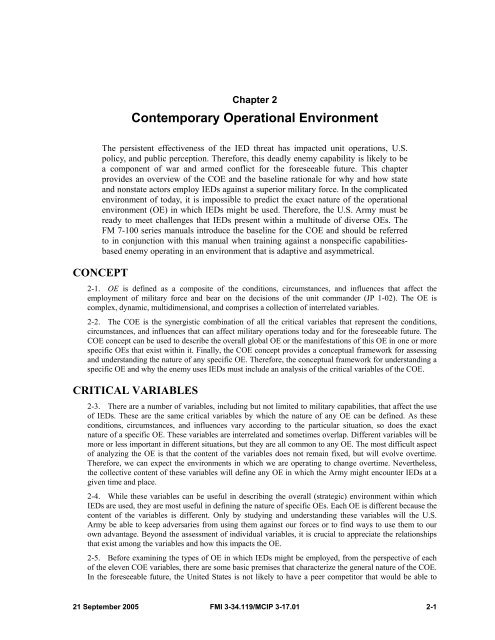FMI 3-34.119 - Soldier Support Institute - U.S. Army
FMI 3-34.119 - Soldier Support Institute - U.S. Army
FMI 3-34.119 - Soldier Support Institute - U.S. Army
Create successful ePaper yourself
Turn your PDF publications into a flip-book with our unique Google optimized e-Paper software.
Chapter 2Contemporary Operational EnvironmentThe persistent effectiveness of the IED threat has impacted unit operations, U.S.policy, and public perception. Therefore, this deadly enemy capability is likely to bea component of war and armed conflict for the foreseeable future. This chapterprovides an overview of the COE and the baseline rationale for why and how stateand nonstate actors employ IEDs against a superior military force. In the complicatedenvironment of today, it is impossible to predict the exact nature of the operationalenvironment (OE) in which IEDs might be used. Therefore, the U.S. <strong>Army</strong> must beready to meet challenges that IEDs present within a multitude of diverse OEs. TheFM 7-100 series manuals introduce the baseline for the COE and should be referredto in conjunction with this manual when training against a nonspecific capabilitiesbasedenemy operating in an environment that is adaptive and asymmetrical.CONCEPT2-1. OE is defined as a composite of the conditions, circumstances, and influences that affect theemployment of military force and bear on the decisions of the unit commander (JP 1-02). The OE iscomplex, dynamic, multidimensional, and comprises a collection of interrelated variables.2-2. The COE is the synergistic combination of all the critical variables that represent the conditions,circumstances, and influences that can affect military operations today and for the foreseeable future. TheCOE concept can be used to describe the overall global OE or the manifestations of this OE in one or morespecific OEs that exist within it. Finally, the COE concept provides a conceptual framework for assessingand understanding the nature of any specific OE. Therefore, the conceptual framework for understanding aspecific OE and why the enemy uses IEDs must include an analysis of the critical variables of the COE.CRITICAL VARIABLES2-3. There are a number of variables, including but not limited to military capabilities, that affect the useof IEDs. These are the same critical variables by which the nature of any OE can be defined. As theseconditions, circumstances, and influences vary according to the particular situation, so does the exactnature of a specific OE. These variables are interrelated and sometimes overlap. Different variables will bemore or less important in different situations, but they are all common to any OE. The most difficult aspectof analyzing the OE is that the content of the variables does not remain fixed, but will evolve overtime.Therefore, we can expect the environments in which we are operating to change overtime. Nevertheless,the collective content of these variables will define any OE in which the <strong>Army</strong> might encounter IEDs at agiven time and place.2-4. While these variables can be useful in describing the overall (strategic) environment within whichIEDs are used, they are most useful in defining the nature of specific OEs. Each OE is different because thecontent of the variables is different. Only by studying and understanding these variables will the U.S.<strong>Army</strong> be able to keep adversaries from using them against our forces or to find ways to use them to ourown advantage. Beyond the assessment of individual variables, it is crucial to appreciate the relationshipsthat exist among the variables and how this impacts the OE.2-5. Before examining the types of OE in which IEDs might be employed, from the perspective of eachof the eleven COE variables, there are some basic premises that characterize the general nature of the COE.In the foreseeable future, the United States is not likely to have a peer competitor that would be able to21 September 2005 <strong>FMI</strong> 3-<strong>34.119</strong>/MCIP 3-17.01 2-1
















